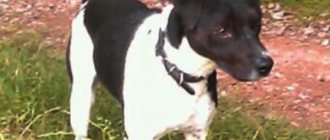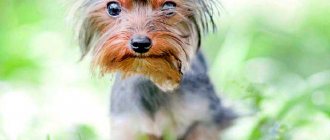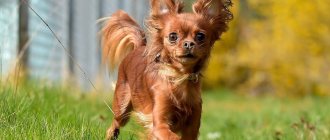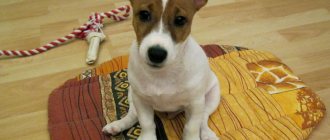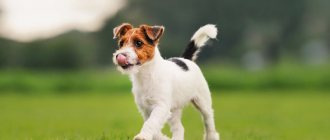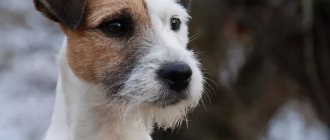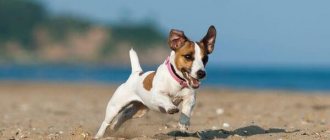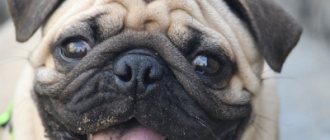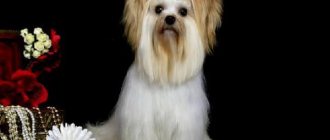The Jack Russell Terrier is one of the hunting dog breeds.
Previously, this dog was widely used for hunting - catching hares, foxes and other small animals.
Now this type of breed is being kept as a pet, a loyal friend and an excellent companion.
This breed is perfect for keeping both in a country house and in an apartment.
In this article we will talk about such a breed variety of these dogs as the Mini Jack Russell Terrier, and show their photos.
History of the Jack Russell Terrier breed
Smooth-haired Jack Russell Terrier
There are breeds that have lived side by side with humans for so long that it is only possible to reliably learn about their roots with the help of geneticists. This is, for example, the situation with the ancestors of Jack Russells - fox terriers. Their first descriptions are found in Roman chronicles from the time of Caesar’s campaigns against Albion.
But the closer we get to modern times, the more documentary evidence there is, so today no one doubts that the Jack Russell Terrier owes its appearance to a very specific enthusiast - John “Jack” Russell. Following family tradition, he became a priest and headed a small parish in the south of Britain, but this man’s true passion remained not serving the church, but parfors hunting and breeding dogs for it.
Even in John's last year of study at Exeter College, Oxford University, a significant meeting took place. During one of his walks, he saw a dog that embodied the ideal qualities of a real fox hunter: compact size, passion, vigilance and fearlessness. The treasure belonged to a local milkman, who was unlikely to be able to fully appreciate the mentioned advantages, so the first owner immediately gave Trump up to a persistent student. With this Trump - this is how the English word Trump is translated - many years of selection work began.
Of course, outwardly, the ancestor of the breed does not look so much like the current “Jacks”. The similarity is noticeable only in color: against the dominant white background, darker spots stood out in the area of the eyes, ears and at the base of the hook-shaped tail. Judging by the surviving drawings, Trump was a poor-boned dog with a small skull. Most likely, her family included the now extinct English White Terriers.
It must be said that in the process of breeding a new breed, the pastor used representatives of various burrow dogs. There is no exact data about experiments with the gene pool, since the breeder did not keep any journals with records, or they simply did not survive. Researchers believe that fox terriers of the old format, border dogs, lakelands, Irish terriers, and Scottish cairns left their mark on the formation of the breed. Russell set himself the task of improving the working qualities of the offspring, and he did not consider it necessary to cull puppies because of the shape of the skull or the position of the tail. As a result, the unsightly and roughly cut short-legged pets of the Devonshire priest won the ardent love of all the surrounding hunters.
Although the vicar himself was involved in boxing (which in the 19th century was a very tough sport, because protective gloves were not used), he was not prone to cruelty and publicly condemned those fellow breeders who mixed the blood of fighting dogs into terriers. For John, fox hunting was incompatible with killing or severely injuring prey; he considered the main goal to be a competition between foxes and his animals in speed and endurance. Russell's terriers did not require the ferocity and powerful jaws of a bulldog.
Wirehaired Jack Russell Terrier puppy
The pastor's achievements in breeding and popularizing terriers did not go unnoticed. In 1873, he, along with Sewallis Shirley and a dozen like-minded people, took part in the creation of the organization that is today known as the oldest kennel club - the English Kennel Club. In subsequent years, John Russell was invited as a judge to exhibitions, but did not exhibit his own pets, calling them wild rose hips against a background of greenhouse roses. And this comparison was not in favor of the latter.
John Russell, who devoted much of his life to dog breeding, died at the age of 87 and was buried in the village of Swimbridge - in the cemetery next to the medieval church of St. James, where he served. Since he actively sold puppies and adult dogs, at the time of his death the breeder had only 4 dogs.
The development of the breed was continued by a young colleague, Arthur Heinemann. He is the author of the first draft of the breed standard. In 1914, the Parson Jack Russell Terrier Club (parson means “priest”) was founded and existed until the 40s. In the middle of the century, Russell's terriers began to be crossed with dachshunds and Welsh corgis to improve their character and working qualities. As a result, not only “classic” animals, but also short-legged animals began to appear. The latter were considered undesirable for a long time and in the eyes of the jury invariably lost to their tall brothers.
It is unknown what the fate of the “side branch” would have been if, in the 1960s, several dogs with short legs had not ended up on the Green Continent. The Australians, of course, did not intend to hunt with them, but they appreciated the energy and intelligence of their new pets, so they took up the development of the breed with great enthusiasm.
Official recognition by the Kennel Club and the FCI came only in 1990. Then both types of dogs were included in the standard of the International Canine Organization under the general name Parson-Jack Russell Terrier. However, activists from the UK and Australia did not give up attempts to achieve differentiation, and in 2001 two standards were adopted: for the Parson Russell Terrier (animals with long legs with a square body) and the Jack Russell Terrier (short legs with an elongated body).
Breed traits
Breed traits (on a 5-point scale)
| Jack Russell Terrier | |||
| Activity | in the house | 4 | |
| on the street | 4.6 | ||
| Obedience | training | 3.2 | |
| strangers | 3.4 | ||
| Domination | in family | 3.5 | |
| over dogs | 3.9 | ||
| Defending your territory | from people | 3.2 | |
| from dogs | 3.9 | ||
| Sociability | in family | 4.5 | |
| with strangers | 3.5 | ||
| with dogs | 2.8 | ||
| Concentration | in family | 1.7 | |
| in front of strangers | 2 | ||
| with dogs | 1.9 | ||
| Aggressiveness | in family | 1.7 | |
| to strangers | 2.7 | ||
| to the dogs | 3.2 | ||
| to cats | 3.7 | ||
| Family behavior | calmness | 4.1 | |
| demand for affection | 4.4 | ||
| excitability | 4.5 | ||
| playfulness | 4.6 | ||
| excessive barking | 3.3 | ||
| behavioral breakdowns | 2.4 | ||
| Tolerance for children | up to 4 years | 2.7 | |
| over 4 years old | 3.3 | ||
| Institutional use | watchman | 4.4 | |
| bodyguard | 2.7 | ||
This breed is often compared to the following dog breeds: Beagle, Dachshund, Miniature Pinscher (Dwarf Pinscher), Pembroke Welsh Corgi, Yorkshire Terrier.
You can get acquainted with the representatives of the breed using the photo:
Jack Russell Terrier
Jack Russell Terrier
Hunting qualities
Like many other members of the terrier group, Jack Russell Terriers were bred to hunt small, burrow-dwelling game. Of course, terriers do not have enough speed and power for tracking and pursuit, but English foxhounds or other hounds did an excellent job with this task, but in penetrating an underground shelter and in a fight forcing the “fugitive” to leave it, the persistent and compact hounds have no equal strong guys.
Jack Russell exploring the hole
It was already mentioned above that Jack Russell Terriers gained their reputation as excellent burrow dogs not for their ferocity, but for their clear voice and high intelligence. They not only understood the hunters’ strategy in a given situation, focusing on various horn signals, but also made their own decisions, which helped save energy without sacrificing efficiency.
Since their introduction, "jacks" have been an integral part of rural life in Great Britain. However, since 2002 in Scotland, and since 2005 in England and Wales, fox hunting has been officially banned, although for many it was part of the country's cultural heritage. Badgers are also now protected by conservation organizations. In southern Spain there is still a hunting area where it is possible to pursue game on horseback, but in most European countries the tradition is fading into history due to the lack of uninhabited areas with suitable landscape.
But innate instincts cannot be canceled as easily as centuries-old rituals, so four-legged “city dwellers” do not miss the opportunity during a walk to chase a passing cat or dig an impressive hole in the roots of trees from the nearest park.
Origin, history, creation
The Jack Russell Terrier dog owes its origin to the English pastor John Russell, nicknamed Jack. The formation of the breed begins in 1818, when a priest purchased a bitch named Trump in Oxford. He was a passionate hunter and he bought dogs for hunting small game. “The ancestor” Trump had little resemblance to modern representatives of the Jack Russell Terrier breed. But what has remained unchanged is the color. Trump had white fur with bronze-red markings on her head and a tan patch at the base of her tail.
Purposeful crossing of Trap and her offspring with white and colored terriers led to the creation of the breed in its modern form. Some breeders even practiced crossing with bull and terriers to give the Jack Russell terriers fighting qualities. However, this was more common during the heyday of dog fighting. But after their ban in 1835, this practice began to decline, but you can still find descendants of dogs crossed with bulldogs. They can be recognized by their stocky body, wider head and lack of a clear voice.
Some researchers believe that the Jack Russell Terrier is the same fox terrier only of the old type. Considering that John Russell was among the founders of the Kennel Club, created for breeding the Fox Terrier breed, this version has a right to exist. The pastor himself never classified the dogs he bred as fox terriers, claiming that his dogs were created exclusively for hunting, while fox terriers were created for exhibitions.
After the death of John Russell in 1883, his dogs were called “working terriers”; only in the 30s of the 19th century the breed was given the name of its creator.
For what purpose was the Jack Russell Terrier breed bred?
The short-legged, miniature Jack Russell Terrier breed was bred to hunt burrowing animals. What were the requirements for the future breed:
- Short hair, since the dog's long hair would stick to dirt after being in the hole. The coated terrier significantly lost speed - the main weapon of a hunting dog.
- Light in color, preferably white, to distinguish the dog from the fox he drove out of the hole. In practice, there have been more than once cases where hunters shot at their dogs running out of a hole, taking them on a fox. Terriers were highly valued by their owners, so the breeders aimed to consolidate the white color with red markings.
- Drop ears. Standing was undesirable.
The dog bred by John Russell met all these requirements. Her character was decisive and brave. The terrier was brave and vicious towards the beast, and had a strong hunting passion. Jack Russell Terriers have been recognized as the best burrow hunters. They were used not only for hunting foxes, but also for catching badgers, rats, and hares.
Interesting! The Jack Russell Terrier has no equal in catching rodents. Thus, dogs of the breed named Vampire killed about 1 ton of rats in Great Britain in 1977.
The Jack Russell Terrier breed in modern times
Now the breed is very popular in Europe and Australia. In its homeland it is used as a hunting and farm dog. She is happily kept in houses and apartments as a companion dog. As a hunting dog, it is used to hunt foxes and badgers. But after the ban on catching badgers, hunters release them after the dog catches them. On farms, the Jack Russell Terrier does an excellent job guarding poultry and small livestock from foxes and rats.
French hunters take Jack Russell terriers to hunt feathered and fur-bearing game. The dogs bring them the shot animal. Dogs can even fetch ducks from the water. They are also used for hunting wild boar, deer, rabbits, and roe deer.
Appearance of Jack Russell Terriers
The Jack Russell Terrier is a small but powerfully built dog. Height at the withers is 25-30 cm. There are no strict weight standards, however, experts note that the Jack Russell Terrier looks harmonious, having 1 kg of weight for every 5 cm of height, that is, the desired weight of an adult representative of this breed is 5-6 kg.
Body
Who is there?
The silhouette of the Jack Russell Terrier is strictly rectangular, elongated (the length from the withers to the base of the tail is greater than the height at the withers).
Head
The skull is flat and moderately wide. The muzzle is somewhat shorter than the skull. The transition from forehead to muzzle is well defined, but not too pronounced.
Nose
Careful. The lobe is black. The nostrils are developed and well open.
Eyes
Almond-shaped, dark. Not bulging, the eyelids lie close to the eyeball and are darkened along the edges.
Teeth and jaws
The Jack Russell Terrier's jaws should be strong, powerful, and have strong teeth. Scissor bite. The lips are black and tightly closed.
Jack Russell Terrier admiring the sunset
Ears
"Buttons" or hanging. Small, folded in front. Extremely flexible, can rotate 180°. The tips are V-shaped.
Neck
Strong, with a clean, crisp line.
Frame
The croup is even. The loin is short, strong and muscular. The back is strong and fairly narrow.
Breast
Deep, not wide. The ribs are strongly prominent at the base and noticeably flattened at the sides. The circumference of the ribs behind the elbows is 40-43 cm.
Tail
At rest, the Jack Russell Terrier's tail may be lowered, but when moving, it always rises.
Forelegs
They look the same both from the front and from the side. Straight, well set under the body. The shoulder blades have a good slope back and are not overloaded with muscles.
Hind limbs
Strong and muscular. The knee joints are strongly bent, the hocks are low. The metatarsals are parallel when viewed from behind.
Paws
Small, round in shape, with hard pads. Placed straight. The fingers are medium rounded.
Wool
Jack Russell Terriers have three types of coat: hard, smooth or kinky. Should provide good weather protection.
Color
Predominant white background with dark spots. The color of the spots can vary from black and dark chestnut to red.
How and whom to choose? Price range
It is better to buy a dog from a trusted specialized nursery, after asking the breeder about the health of the puppy and its parents.
In a healthy and purebred Jack Russell puppy:
- white coat with spots of red or black;
- dark eyes with black rims;
- black nose without discharge;
- medium-length tail, not curled into a ring;
- limbs straight and even;
- straight and level back.
The puppy should be active, playful and curious.
When choosing between a dog and a bitch, you should remember that girls are more affectionate and calm, they have a more balanced character, while boys are more energetic and courageous.
Males also tend to mark territory and lose control when they smell a bitch in heat; girls don’t have these problems, but they go into heat twice a year, during which their behavior can change.
What is the price? Prices for a purebred puppy with all the necessary documents start from 35 thousand rubles, show-class puppies that compete for prizes at exhibitions are sold for 50 thousand rubles. and more .
If the documents and titles of the parents do not matter, then a Jack Russell can be purchased for 13-20 thousand rubles.
Photo of an adult Jack Russell Terrier
Character and habits
In addition to being an excellent companion dog, it is also an excellent terrier, capable of going into a hole after prey. The cute-looking dog is actually a fearless predator, cunning and deadly to foxes, badgers, hares and otters.
- The breed was bred to be strong and resilient enough to participate in the hunt together with the pack, fearlessly climb into a fox’s hole, work with its voice, and calmly tolerate the company of other dogs. To perform such tasks, the dog had to be purposeful and aggressive.
- Its small size allows you to keep a dog in a city apartment. Jack Russell, when properly raised, is a very obedient dog; you can safely walk with him in city parks; he behaves friendly towards other dogs.
Future Jack Russell owners should keep the following features in mind:
- Jack Russells love to dig. In a matter of minutes they can dig a hole or tunnel under a fence;
- They have a fairly clear voice and can bark for a long time;
- Even very obedient dogs may not be able to stand it if potential prey - a cat or bird - comes into view;
- They love to jump and can jump to a height of up to 1.5 m.
Character of the Jack Russell Terrier
Shall we play?
The Jack Russell Terrier is a real perpetual motion machine. He is simply physically unable to sit in one place for a long time and get bored while waiting for the game. This dog will attract the owner's attention in every possible way. She knows perfectly well the rules of behavior in the house and can deliberately break them in order to provoke at least some reaction from the owner, who is too carried away by his favorite TV series or a new book.
It is important to remember about the high intelligence of your pet. Physical activity must be accompanied by mental activity, otherwise any activity will quickly become boring. Alternate teams and toys, come up with new types of activities.
In general, representatives of the breed are distinguished by their cheerful and friendly disposition. Jack Russell Terriers are great for families where the children are old enough not to treat the pet like a teddy bear. Only dogs whose upbringing has made serious mistakes since early childhood can show aggression for no reason.
Representatives of this breed do not get along well with other animals in the house due to the hunter genes. Neighborhood with rodents is especially undesirable, because Jack Russells are famous rat catchers, but they can also cause trouble for cats. In relations with dogs of their own or another breed (regardless of the size of the enemy), due to their brave and capricious nature, they will always try to dominate, constantly getting into skirmishes.
Character traits
Mini Jacks, like all species of this breed, have their own special qualities and character.
Dog character:
- lively - always ready for new exploits;
- charismatic - every dog has an exceptional quality that can’t help but make you fall in love with it;
- meek - knows how and when to behave correctly;
- cheerful - never misses a chance to play;
- inquisitive - will not sit still if something interesting is happening nearby.
Positive qualities include:
- courage - the dog will bravely rush into battle if the owner is threatened by something;
- agility - thanks to its small stature, the dog can easily get into hard-to-reach places;
- loving - will happily share his warmth and mood with others.
NOTE!
Many of these qualities and personalities make the Miniature Jack Russell easy to train. For best results, you need to train regularly, paying special attention to strength training.
Education and training
Jack Russell Terriers are best suited to experienced owners as they are naturally cunning, independent and have a desire for leadership. If you feel that you cannot fully cope with the character of the new family member, seek advice and help from a canine specialist as soon as possible.
Early socialization of a puppy is important so that in the future he can coexist peacefully with household members (including children and the elderly), other pets, and does not show aggression towards guests and random passers-by during walks.
The main behavioral problems in Jack Russell Terriers include stubbornness, loud barking, damage to household property, anxiety from loneliness, digging and chasing small animals. All of them can be corrected with due attention from the owner. A dog shows the worst sides of its character only if it does not meet with opposition or sees this as the only way to attract the attention of its owner.
The breed lends itself well to training, the main thing is to be patient during the process, not to forget about the reward and not to raise your voice. Establishing the authority of the owner is extremely important, but it can and should be achieved through calm firmness. Your pet should respect and listen to you, and not be afraid.
Puppies
So, we have decided on the breed, it is a Jack Russell Terrier, and the puppy has been selected. What to do next? And then pure friendship begins with the most wonderful pet, a faithful and devoted friend. But a dog’s health and good mood depend on quite ordinary things.
- You need to choose a bowl from which it will be convenient to eat. It should be located at the dog's chest level, so you will need to use a stand. There should always be access to clean water.
- Accustoming to a name is one of the very first tasks in raising a puppy. In order for the dog to begin to respond to the name, you can use food. Having picked up a bowl of food, you need to affectionately call the dog by name. After several such attempts, you can modify them, for example, first call the puppy, and when he looks at you, put a bowl. Or call him, and after responding, offer the puppy an interesting game. Whatever the owner comes up with, the nickname should evoke pleasant associations in the dog.
- The Jack Russell Terrier, whose puppies are very curious, requires training to wear a collar. The little mischief-maker will be frightened by an unfamiliar object. Before you start walking outside, you can put a collar on him a couple of times and treat him with a treat. The puppy will quickly get used to the new accessory and will not be afraid of it. A leash is required during walks to ensure the dog's safety.
- The first walks are not only the beginning of getting to know the world outside the home, but also teaching the puppy to relieve himself outside. If the puppy does this, then you definitely need to express great delight and treat him with a treat so that he understands that going to the toilet outside is good. If your dog has difficulty with this, you can take a diaper with you wherever your dog goes at home.
If you arrange walks depending on the natural rhythm of the body, then the training will go much faster. After feeding, sleeping or active play, puppies most often relieve their natural needs. In a quiet place, the puppy will quickly learn to do what is wanted of him.
Care and maintenance
Despite the compact size of Jack Russells, keeping them in a city apartment is fraught with certain difficulties. Dogs are too active for quarter-hour walks in the morning and evening to satisfy their need for exercise. With a lack of training, they will spend excess energy on destructive pranks. As a result, furniture, appliances, floors, shoes and clothes of the owners may be damaged. It should be understood that for the Jack Russell Terrier this is not an act of revenge or deliberate sabotage, but simply an attempt to occupy itself with something in the absence of the owner, so before leaving for several hours you need to find time for a long and meaningful walk.
From a young age, your pet should know that he has his own territory in the house. Choose a location that is protected from drafts and not too close to heat sources. It is necessary to purchase a natural mattress that is strong enough to withstand the attacks of powerful teeth. You should keep toys nearby that your Jack Russell Terrier can chew with impunity after waking up.
Grooming will not cause excessive trouble, although this breed, if kept completely indoors, sheds throughout the year. Only wire-haired terriers need trimming with special tools; the rest need regular brushing. Frequent bathing is contraindicated because it damages the natural protective layer on the pet's fur and skin. After walks, just wipe your paws with a damp towel or animal wipes.
Teeth should be brushed once or twice a week using a specialized toothpaste. Inspect and clean your ears twice a month.
The Jack Russell Terrier has standard nutritional requirements. Either premium and super-premium food, or balanced natural food. In the latter case, the ratio of meat (beef, veal, cooked poultry and offal) and plant components should be 2:1.
Photo
Jack Russell Terrier in the spring forestYou have met the Jack Russell Terrier breed, the photo of which is presented above. Movable, active and persistent, she will never let her owner and his family get bored. The Jack Terrier is very artistic, which plays into the hands of directors who are happy to feature representatives of the breed in films.
Interesting facts about the breed:
The agility and mobility of Jack Russell Terriers is legendary. The dog Anastasia even entered the Guinness Book of Records in 2011. The miniature dog popped 100 balloons in less than 45 seconds.
A wave of popularity swept over the dogs of the breed after the release of the film “The Mask” with comedian Jim Carrey.
In Russia, the Jack Russell Terrier became known only in 1999, and was brought not from the homeland of the breed, but from the USA, the state of Virginia.
For your pet, any hole in the ground can become an object of unbridled curiosity. Being burrowing hunting dogs, they are ready to create a hole out of any hole, dig a tunnel in a flower bed, and look for or bury “treasures” in beds.
Health and disease of the Jack Russell Terrier
Playing Frisbee with a Jack Russell
In general, Jack Russell Terriers can be called hardy dogs with good health. But they are not immune from a number of congenital and acquired diseases:
- osteochondropathy of the femoral head (Perthes disease) manifests itself in puppies 4–10 months old in the form of constant or periodic lameness;
- dislocation of the kneecap;
- hip dysplasia, although large breeds are more often considered at risk, does not bypass terriers;
- deafness;
- heart diseases;
- epilepsy;
- hereditary defects in the development of the sclera, choroid, retina, optic nerve and retinal vessels - the so-called collie eye anomaly.
To ensure your pet's well-being and improve his quality of life well into his old age, visit your veterinarian regularly for preventive examinations and follow his recommendations. Do not self-medicate if symptoms of various diseases occur.
Prices
Seeing a mischievous Jack Russell Terrier, many involuntarily wonder whether they should get this wonderful dog and how much a Jack Russell Terrier costs. The price of puppies depends on the pricing policy of the nursery, the origin of the puppy and the title of its parents. Compliance of character and exterior with the standard also affects the cost.
Budget Jack Russell Terriers are representatives of the pet class. They make excellent family pets, but can and most often do have deviations from the standard and cannot be bred. Their price ranges from 10 to 20 thousand rubles.
The price for an elite Jack Russell Terrier puppy is higher, since he came from champion parents, he is also promised a titled future and he fully meets the standard. Breed and show-class puppies can be bought for 25-50 thousand rubles.
How to choose a puppy
The appearance of Jack Russell Terriers on the silver screen and in photo reports from glossy magazines about the lives of celebrities did not have the best effect on the breed. There are many unscrupulous breeders who strive to make a profit from selling popular animals and do not care at all about the gene pool and raising children.
It is very important to buy puppies only from breeders with an impeccable reputation and in the best kennels. Of course, such Jack Russells will cost more, but in the future you will not have to deal with uncontrollable dog behavior or spend all your free time in clinics due to hereditary health problems.
When meeting a Jack Russell Terrier for the first time, it is important to pay attention to the behavior of the chosen puppy. He should be playful, energetic and sociable. Lethargy, apathy and lack of appetite indicate poor health, and aggression or fear of the outside world indicate mental instability. Do not ignore the living conditions of mother and babies. Cleanliness, sufficient space and the presence of toys indicate a responsible attitude of the breeder no less than the presence of official documents and routine vaccinations.
Buying a puppy
The only difficulty that arises when choosing this cheerful and active dog is the price. From a good breeder with documents, it can start from $700. Moreover, the upper limit is limited only by the seller’s imagination. A puppy without distinguished ancestors can be bargained for $500, but for many dog lovers even this amount is unaffordable. For 100-200 dollars you can buy a puppy second-hand, but there is a high risk of purchasing a sick animal. More money will be spent on treating the puppy.
It happens that puppies of this breed are found even in dog shelters. This is a rarity, which only means that the former owner could not get along with the original and cheerful animal. Such a “refusenik” can be obtained for free, but again there are risks. The shelter dog experienced betrayal and could enter a neurotic state. Then the new owner will have to show care and patience, and perhaps turn to a dog trainer to establish contact with the pet.
The conclusion is this - the Jack Russell Terrier is a dog for active and easy-going people who prefer sports, travel and long walks. Any child will be crazy about such a playmate, but elders will not stay away from raising a pet. Jack Russell Terriers help people with disabilities adapt to society. There is a special treatment with the help of four-legged animals - canistherapy. Within its framework, Russell helps treat depression. They become real hormones of joy for children with cerebral palsy, autism and other disorders of the central nervous system.
Photos of Jack Russell Terrier puppies
What do newborn puppies look like?
Puppies are born blind, their muzzle and body do not yet have the proportions of an adult dog, so it is not yet possible to judge their future appearance. This can be done much later.
The puppy's coat already has a color that will remain in the future. The tail is pressed to the body, the ears puff up. The tip of the nose and paws are pink or pinkish in color. The type of coat is not yet clear.
Jack Russell puppies are 14-16 cm in size at birth. Weight usually exceeds 200 g and ranges from 200 to 250 g.
These indicators are not universal, they depend on:
- heredity;
- the period at which the puppies were born;
- number of puppies in the litter.
Development by months
At one month the puppy already has its first teeth:
- fangs;
- incisors;
- the first and second false-root ones.
He begins to emerge from his den along with the other puppies.
This is the time when you need to start toilet training your dog. During the first month, the breeder observes an increase in the puppy’s activity and how he gets used to his name. The dog develops a daily rhythm.
IMPORTANT!
At the age of 45 days it is recommended to brand the puppy. At this time, the baby is also already accustomed to hygiene procedures - combing, cleaning the ears and examining the teeth.
The puppy continues to explore the world. Closer to the age of two months, he begins to better remember commands, chew and ruffle objects around him. He is growing and gaining weight, but at this age it is still impossible to see the puppy’s shortcomings.
Further development occurs in the following order:
- At 2-2.5 months, the puppy begins a period of fear. At this time, you need to communicate with him as much as possible and avoid things that would frighten the dog. Also at this time the puppy is already switching to food. At 2 months, the puppy begins to bark and all of his baby teeth appear. This is the right time to start accustoming him to trips and walks. The dog continues to grow and gain weight;
- from 2 to 5 months, the proportions of the dog’s head and body are determined. Character and teeth change;
- at 3 months the dog is already ready for independent life. During these three months, his individual character traits are formed;
- from 4-8 months the dog begins to want to run away from its owner. This is the time for the dog's "sexy" games. The optimal age to move to a new family. The puppy is fully formed and after changing teeth the bite is visible. At this age, the dog’s character, its preferences and habits are visible;
- at 7-8 months the dog’s growth stops;
- at 8-9 months the dog’s teeth finally change. Fangs that have not fallen out need to be pulled out;
- from 6-10 months the bitch begins her first heat and puberty begins. Males mark their territory and raise their paw;
- 6-12 months is a time of fear of new situations. A new trusting relationship is formed between the dog and the owner. During this period, you should not force the dog to approach the object that it is afraid of;
- at 12 months, the dog completes the formation of the “dominance-submission” relationship.
